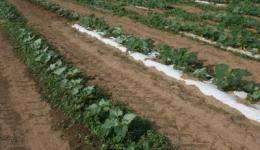Paper mulches evaluated for commercial vegetable production

Polyethylene mulches, used widely in commercial vegetable production to improve crop yields and produce quality, have distinct disadvantages. Disposal options are limited, and plastic mulches often end up in landfills, being burned, or disposed of illegally. Recycling polyethylene mulches is also a challenge; the mulches used in large-scale vegetable production are contaminated with too much dirt and debris to be recycled directly from the field in most power plants and incinerators. Timothy Coolong from the University of Kentucky's Department of Horticulture published a report on paper mulches in HortTechnology that may give vegetable producers viable alternatives to polyethylene.
The recent trend toward eco-friendly production techniques has resulted in a second look at biodegradable paper mulches, which are manufactured from renewable resources and do not have to be removed from the field after harvest. Paper-based mulches have been used in agriculture since 1914, but some paper mulches deteriorate rapidly under field conditions, reducing their effectiveness. Paper mulches have other limitations; since they are heavier than polyethylene, transportation costs are higher, and paper mulches are inherently more expensive than polyethylene.
Coolong's research evaluated the performance of four readily obtainable papers compared with traditional black plastic using conventional plastic laying equipment and a water wheel transplanter. The experiments were conducted in Lexington, Kentucky, over two growing seasons using yellow squash. Crop yield and quality, weed biomass, soil temperatures under the mulch, and mulch degradation were evaluated. Four paper mulches—50-lb kraft paper, 50-lb polyethylene-coated kraft paper, 40-lb white butcher paper, and 30-lb waxed paper—were compared with 1-mil black polyethylene mulch in two weeding treatments (bare-ground hand-weeded and bare-ground nonweeded).
In the Fall 2007 experiment, butcher paper and polyethylene-coated kraft paper controlled weeds as well as black plastic mulch. However, in Spring 2008, black plastic mulch provided superior weed control compared with other mulches. Yields among waxed, butcher, and polyethylene-coated kraft papers were similar to black plastic mulch in 2007, though yields in paper mulch plots were significantly less than plastic mulch in Spring 2008. Coolong observed that most of the paper mulches were able to be placed with a plastic mulch layer, but were not well-suited for use with a water wheel transplanter.
"Our results suggest that in some situations, paper mulches may provide a more sustainable alternative to traditional black plastic mulches. Results with the polyethylene-coated kraft paper suggest that efforts to combine paper with biodegradable films to create mulches may prove worthwhile," observed Coolong. He cautioned that although paper mulches can be effective, cropping conditions and the environment will influence effectiveness, adding that "if paper mulches are ever to be used on a large scale, they will have to be used in conjunction with mulch laying equipment and perhaps mechanical transplanters".
More information: horttech.ashspublications.org/ … nt/abstract/20/2/319
Provided by American Society for Horticultural Science



















